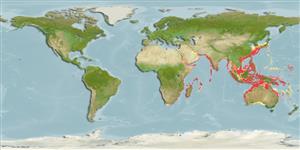Preferred temperature (Ref.
123201): 16.8 - 27.4, mean 23.2 °C (based on 690 cells).
Phylogenetic diversity index (Ref.
82804): PD
50 = 0.5005 [Uniqueness, from 0.5 = low to 2.0 = high].
Bayesian length-weight: a=0.01072 (0.00939 - 0.01223), b=2.97 (2.94 - 3.00), in cm total length, based on LWR estimates for this species (Ref.
93245).
Nível Trófico (Ref.
69278): 3.7 ±0.4 se; based on diet studies.
Generation time: 1.5 (1.2 - 1.7) years. Estimated as median ln(3)/K based on 28
growth studies.
Resiliência (Ref.
120179): Médio, tempo mínimo de duplicação da população 1,4 - 4,4 anos (K=0.2-1.4; tm=3; Fec=20,000; tmax>3).
Prior r = 0.68, 95% CL = 0.45 - 1.03, Based on 16 data-limited stock assessments.
Fishing Vulnerability (Ref.
59153): Low vulnerability (24 of 100).
🛈
Climate Vulnerability (Ref.
125649): Moderate vulnerability (42 of 100).
🛈
Nutrients (Ref.
124155): Calcium = 394 [150, 1,297] mg/100g; Iron = 3.4 [1.2, 8.1] mg/100g; Protein = 19.4 [18.0, 20.9] %; Omega3 = 0.359 [0.161, 0.825] g/100g; Selenium = 148 [46, 441] μg/100g; VitaminA = 10.8 [2.3, 46.9] μg/100g; Zinc = 1.31 [0.73, 2.52] mg/100g (wet weight); based on
nutrient studies. 